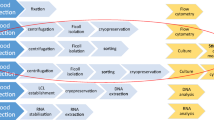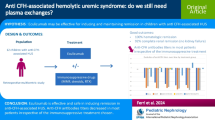Abstract
The aim of our study was to assess the efficacy of red blood cell exchange (RBCx) using a Spectra Optia® automated apheresis system in children with sickle cell disease (SCD). We used automated RBCx to treat acute and chronic complications in 75 children with SCD who had a median age of 10 years [7–13]. We analyzed 649 RBCx sessions. Peripheral venous access was limited in a number of the children, and thus a femoral double-lumen central venous catheter was required. We recommend heparin locking with 500 units in each lumen of the catheter. To prevent complications, we ensured that all patients had achieved a post-RCE HbS level of < 30%. For chronic transfusion, with a post-RCE Hb level of approximately 10–11 g/dL, a blood exchange volume of ≥ 32 mL/kg, and an interval between each RBCx procedure of ≤ 30 days, the residual HbS level was maintained below 30%. For acute transfusion, a post-exchange Hb level ≥ 10 g/dL (p < 0.001) and a total exchange volume ≥ 35 mL/kg (p = 0.001) were the best way to reduce HbS to < 30%. AUC was 0.84. Our results show that erythrocytapheresis was useful and safe for children with SCD.


Similar content being viewed by others
References
Azar S, Wong TE. Sickle cell disease: a brief update. Med Clin N Am. 2017;101(2):375–93.
McGann PT, Nero AC, Ware RE. Current management of sickle cell anemia. Cold Spring Harb Perspect Med. 2013;3(8):a011817.
Russo G, De Franceschi L, Colombatti R, Rigano P, Perrotta S, Voi V, et al. Current challenges in the management of patients with sickle cell disease—a report of the Italian experience. Orphanet J Rare Dis. 2019;14(1):120.
Gluckman E, Cappelli B, Bernaudin F, Labopin M, Volt F, Carreras J, et al. Sickle cell disease: an international survey of results of HLA-identical sibling hematopoietic stem cell transplantation. Blood. 2017;129(11):1548–56.
Merlin E, Hequet O, Kanold J. Red blood cell exchange in children and adolescents with sickle cell disease. Transfus Apher Sci. 2019;58(2):136–41.
Fort R. Recommendations for the use of red blood cell exchange in sickle cell disease. Transfus Apher Sci. 2019;58(2):128–31.
Thibodeaux SR, Tanhehco YC, Irwin L, Jamensky L, Schell K, O’Doherty U. More efficient exchange of sickle red blood cells can be achieved by exchanging the densest red blood cells: an ex vivo proof of concept study. Transfus Apher Sci. 2019;58(1):100–6.
Dedeken L, Lê PQ, Rozen L, El Kenz H, Huybrechts S, Devalck C, et al. Automated RBC exchange compared to manual exchange transfusion for children with sickle cell disease is cost-effective and reduces iron overload. Transfusion. 2018;58(6):1356–62.
Driss F, Hequet O. Red blood cell exchange techniques and methods. Transfus Apher Sci. 2019;58(2):132–5.
Raba M. Selecting red blood cell units to perform RBCX in patients with sickle cell disease. Transfus Apher Sci. 2019;58(2):142–6.
Mehra RA, Gupta SA, Borkar DB. Manual red cell exchange transfusion to avert sickle cell related complications. Asian J Transfus Sci. 2018;12(2):157–9.
Biller E, Zhao Y, Berg M, Boggio L, Capocelli KE, Fang DC, et al. Red blood cell exchange in patients with sickle cell disease-indications and management: a review and consensus report by the therapeutic apheresis subsection of the AABB. Transfusion. 2018;58(8):1965–72.
Choi SJ, Cho H, Eom KS, Lee JW, Kim Y, Lim J. Effective sickle hemoglobin reduction by automated red cell exchange using Spectra Optia in three Emirati patients with sickle cell disease before allogeneic hematopoietic stem cell transplantation. Blood Res. 2018;53(4):325–9.
Willits I, Cole H, Jones R, Carter K, Arber M, Jenks M, et al. Spectra Optia(®) for automated red blood cell exchange in patients with sickle cell disease: a NICE Medical Technology Guidance. Appl Health Econ Health Policy. 2017;15(4):455–68.
Willits I, Cole H, Jones R, Carter K, Arber M, Jenks M, et al. Spectra Optia® for automated red blood cell exchange in patients with sickle cell disease: a NICE medical technology guidance. Appl Health Econ Health Policy. 2017;15(4):539
National Institute for Health and Care Excellence. Spectra Optia for automated red blood cell exchange in patients with sickle cell disease. 2016. https://www.nice.org.uk/guidance/indevelopment/gid-mt271. Accessed 8 Apr 2016.
Cedar Healthcare Technology Research Centre. Spectra Optia apheresis system for automated red blood cell exchange in patients with sickle cell disease. 2015. https://www.nice.org.uk/guidance/MTG28/documents/submission-of-evidence-by-sponsor-4. Accessed 13 Apr 2016.
Matevosyan K, Anderson C, Sarode R. Isovolemichemodilution-red cell exchange for prevention of cerebrovascular accident in sickle cell anemia: the standard operating procedure. J Clin Apher. 2012;27(2):88–92.
Sarode R, Matevosyan K, Rogers ZR, Burner JD, Rutherford C. Advantages of isovolemic hemodilution-red cell exchange therapy to prevent recurrent stroke in sickle cell anemia patients. J Clin Apher. 2011;26(4):200–7.
Adams RJ, McKie VC, Nichols F, Carl E, Zhang DL, McKie K, et al. The use of transcranial ultrasonography to predict stroke in sickle cell disease. N Engl J Med. 1992;326:605–10.
Adams RJ, McKie VC, Carl EM, Nichols FT, Perry R, Brock K, et al. Long-term stroke risk in children with sickle cell disease screened with transcranial Doppler. Ann Neurol. 1997;42:699–704.
Adams RJ, McKie VC, Hsu L, Files B, Vichinsky E, Pegelow C, et al. Prevention of a first stroke by transfusions in children with sickle cell anemia and abnormal results on transcranial Doppler ultrasonography. N Engl J Med. 1998;339:5–11.
Howard J. Sickle cell disease: when and how to transfuse. Hematol Am Soc Hematol Educ Progr. 2016;2016(1):625–31.
Aznar C, La Ruche G, Laventure S, Carme B, Liegeard P, Hontebeyrie M. Seroprevalence of trypanosomacruzi infection in French Guiana. Mem Inst Oswaldo Cruz. 2004;99(8):805–8.
Estcourt LJ, Fortin PM, Hopewell S, Trivella M, Wang WC. Blood transfusion for preventing primary and secondary stroke in people with sickle cell disease. Cochrane Database Syst Rev. 2017;1:CD003146.
Koehl B, Sommet J, Holvoet L, Abdoul H, Boizeau P, Ithier G, et al. Comparison of automated erythrocytapheresis versus manual exchange transfusion to treat cerebral macrovasculopathy in sickle cell anemia. Transfusion. 2016;56:1121–8.
Masera N, Tavecchia L, Pozzi L, Riva F, Vimercati C, Calabria M, et al. Periodic erythroexchange is an effective strategy for high risk paediatric patients with sickle-cell disease. Transfus Apher Sci. 2007;37:241–7.
Duclos C, Merlin E, Paillard C, Thuret I, Demeocq F, Michel G, et al. Long-term red blood cell exchange in children with sickle cell disease: manual or automatic? Transfus Apher Sci. 2013;48:219–22.
Kuo KH, Ward R, Kaya B, Howard J, Telfer P. A comparison of chronic manual and automated red blood cell exchange transfusion in sickle cell disease patients. Br J Hematol. 2015;170:425–8.
Filhon B, Dumesnil C, Holtermann C, Bastit D, Schneider P, Vannier JP. Advantages and difficulties of an erythrocytapheresis program for sickle-cell patients: a pediatric experience. Arch Pediatr. 2012;19:572–8.
Cohen AR, Martin MB, Silber JH, Kim HC, Ohene-Frempong K, Schwartz E. A modified transfusion program for prevention of stroke in sickle cell disease. Blood. 1992;79:1657–61.
Aygun B, McMurray MA, Schultz WH, Kwiatkowski JL, Hilliard L, Alvarez O, et al. Chronic transfusion practice for children with sickle cell anaemia and stroke. Br J Haematol. 2009;145:524–8.
Pegelow CH, Adams RJ, McKie V, Abboud M, Berman B, Miller ST, et al. Risk of recurrent stroke in patients with sickle cell disease treated with erythrocyte transfusions. J Pediatr. 1995;126:896–9.
Scothorn DJ, Price C, Schwartz D, Terrill C, Buchanan GR, Shurney W, et al. Risk of recurrent stroke in children with sickle cell disease receiving blood transfusion for at least five years after initial stroke. J Pediatr. 2002;140:348–54.
Ware RE, Davis BR, Schultz WH, Brown RC, Aygun B, Sarnaik S, et al. Hydroxycarbamide versus chronic transfusion for maintenance of transcranial doppler flow velocities in children with sickle cell anaemia-TCD With Transfusions Changing to Hydroxyurea (TWiTCH): a multicentre, open-label, phase 3, non-inferiority trial. Lancet. 2016;387:661–7.
Michon B, Moghrabi A, Winikoff R, Barrette S, Bernstein ML, Champagne J, et al. Complications of apheresis in children. Transfusion. 2007;47:1837–42.
Kara A, Turgut S, Cagli A, Sahin F, Oran E, Tunç B. Complications of therapeutic apheresis in children. Transfus Apher Sci. 2013;48:375–6.
Delville M, Manceau S, Ait Abdallah N, Stolba J, Awad S, Damy T, et al. Arterio-venous fistula for automated red blood cells exchange in patients with sickle cell disease: complications and outcomes. Am J Hematol. 2017;92(2):136–40.
Sarode R, Ballas SK, Garcia A, Kim HC, King K, Sachais B, et al. Red blood cell exchange: 2015 American Society for Apheresis consensus conference on the management of patients with sickle cell disease. J Clin Apher. 2017;32(5):342–67.
Hartwig D, Schlager F, Bucsky P, Kirchner H, Schlenke P. Successful long-term erythrocytapheresis therapy in a patient with symptomatic sickle-cell disease using an arterio-venous fistula. Transfus Med. 2002;12:75–7.
Acknowledgements
The authors would like to thank Pr Mathieu NACHER from the INSERM U1424 of Cayenne Hospital, Rue des flamboyants, BP 6006, 97306 Cayenne Cedex, French Guiana, for his advice and corrections.
Funding
There is no funding related to this study.
Author information
Authors and Affiliations
Contributions
NE analysed the data and drafted the manuscript, VV, EM, EC, MP, PS and FM collected the data, provided necessary logistic support and have read the manuscript. NE and FM provided critical comments on the manuscript. I confirm that all authors read and approved the final manuscript.
Corresponding author
Ethics declarations
Conflicts of interest
The authors declare that they have no competing interests.
Additional information
Publisher's Note
Springer Nature remains neutral with regard to jurisdictional claims in published maps and institutional affiliations.
In memoriam of Thierry Basset.
About this article
Cite this article
Elenga, N., Vantilcke, V., Martin, E. et al. Red blood cell exchange in children with sickle cell disease. Int J Hematol 115, 107–113 (2022). https://doi.org/10.1007/s12185-021-03221-8
Received:
Revised:
Accepted:
Published:
Issue Date:
DOI: https://doi.org/10.1007/s12185-021-03221-8




